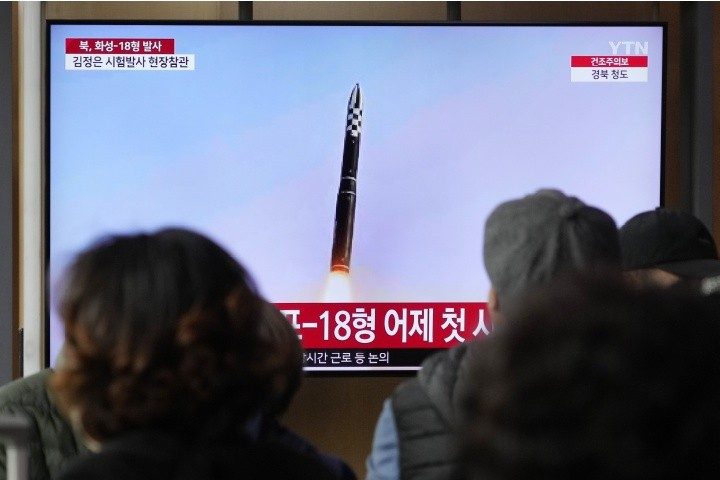
On April 14, the communist state of North Korea announced that it tested the Hwasong-18, a new solid-fuel intercontinental ballistic missile (ICBM), to “radically promote” its nuclear counterattack capability, according to state media.
North Korean dictator Kim Jong-un guided the test, and claimed it would cause North Korea’s enemies to “experience a clearer security crisis, and constantly strike extreme uneasiness and horror into them by taking fatal and offensive counter-actions until they abandon their senseless thinking and reckless acts.”
South Korea’s defense ministry claimed North Korea was still developing the weapon, and that more time was required for the communist state to master the technology, hinting that Pyongyang might conduct further tests.
North Korean state media outlet KCNA published photos of Kim watching the launch, together with his wife, sister, and daughter. Based on the published photos, the missile was draped in camouflage nets on a mobile launcher.
A state media video depicted the missile blasting off from a launch tube, generating a cloud of smoke.
KCNA reported: “The development of the new-type ICBM Hwasongpho-18 will extensively reform the strategic deterrence components of the DPRK [Democratic People’s Republic of Korea], radically promote the effectiveness of its nuclear counterattack posture and bring about a change in the practicality of its offensive military strategy.”
“Pho” refers to “artillery” in the Korean language.
Analysts contended that this test signifies the North’s first use of solid propellants in an intermediate-range or intercontinental ballistic missile.
Developing a solid-fuel ICBM has been a longstanding goal of North Korea, as it could help the communist dictatorship of the Kim family mobilize missiles more rapidly in wartime.
The majority of the country’s largest ballistic missiles use liquid fuel and need to be loaded with propellant at their launch sites. However, this process is time-consuming and risky.
“For any country that operates large-scale, missile-based nuclear forces, solid-propellant missiles are an incredibly desirable capability because they don’t need to be fuelled immediately prior to use,” said Ankit Panda, a senior fellow at the U.S.-based Carnegie Endowment for International Peace.
“These capabilities are much more responsive in a time of crisis.”
Most likely, North Korea will retain some liquid-fuel systems, making it more challenging for the United States and its allies to assess its moves during a conflict, Panda elaborated.
Vann Van Diepen, a former U.S. government weapons expert who now works with the 38 North project, remarked that solid-fuel missiles are easier and safer to operate, and require less logistical support. Thus compared to liquids, these solid-fuel missiles are harder to monitor.
In December 2022, after testing a high-thrust solid-fuel engine, North Korea first unveiled what could be a new solid-fuel ICBM during a military parade in February this year.
Observers said the United States would be able to ascertain a solid- or liquid-fuelled launch via early warning satellites that can identify disparities in the infrared data generated by various missile types.
This latest launch came after Kim urged for his country to boost war deterrence in a “more practical and offensive” manner to counter what he slammed as provocation by the United States.
The missile, launched from near Pyongyang, flew about 1,000 kilometers before landing in waters east of North Korea, officials announced.
A South Korean military official observed that the missile’s maximum altitude was lower than 6,000 kilometers, the peak of some of last year’s milestone tests.
“North Korea could have opted to focus on collecting data necessary to check its features at different stages than going full speed at the first launch,” said Professor Kim Dong-yup from the University of North Korean Studies.
“As it was a test that did not demonstrate its normal flight pattern, North Korea will likely conduct some more tests.”
“This [solid] propellant is cast into the missile’s airframe when the missile is built: Imagine a firecracker rocket, ready to go,” Ankit Panda, a nuclear policy expert at the Carnegie Endowment for International Peace, told AFP.
On the contrary, liquid-fuelled missiles usually necessitate fuel and an oxidizer to be installed in the missile before they can be fired. Thus, firing liquid-fuelled missiles would be more time-consuming and troublesome than firing solid-fuel ones.
Getting a liquid-fuel missile ready for launch “takes time just like pumping petrol to your car,” said Dr. Cheong Seong-chang, director of the Centre for North Korean Studies at the Sejong Institute.
Rather, a solid-fuel missile can be regarded as a “portable battery,” providing users much greater flexibility, Dr. Cheong said.
Additionally, once a liquid-fuel missile is prepared, “it has to be fired within a short period of time — which is not something you have to worry about with solid-fuel missiles”, he added.
Solid-fuel missiles do need to be stored, maintained, and treated with care, failing which, their quality can deteriorate as time passes, causing them to fail, Panda warned.
However, one can usually mobilize and launch them more rapidly during a war compared with liquid-fuelled missiles. This “makes solid fuel missiles very attractive for a number of military applications,” he continued.
One can see the missile’s exhaust plume, which is “consistent with a dirty, smoky solid propellant at work,” in North Korean state media photographs, said Panda.
“Everything looks consistent with a successful solid-fuel ICBM test,” he added.
Nonetheless, even if the North Koreans have conducted one successful test of the new weapons system, it will still “be likely some way from credible deployment in any meaningful numbers,” opined Joseph Dempsey, a defense researcher at the International Institute for Strategic Studies.
Also, major questions persist over whether North Korea’s ICBMs are effectively functional. While they have been tested several times, tests have been done only on a lofted trajectory and not in real-life conditions.
That being said, as North Korea’s “threshold for what is effectively fielded is likely different from others,” the North Koreans may deem the new weapon as operational even if other militaries would necessitate more rounds of testing.
South Korea’s defense ministry stated that it believes the North’s recent launch was simply a preliminary test and that developing the Hwasong-18 properly “would need additional time and effort.”
“Pyongyang still faces many technical hurdles and resource constraints to actually deploy the missile forces it advertises in state media,” Associate Professor Leif-Eric Easley of Ewha University said, as cited by AFP.
Most militaries “first start off with liquid fuel missile technology but soon strive to acquire solid fuel missiles, which require more advanced technology,” highlighted Dr. Cheong.
It must be noted that not all advanced militaries solely mobilize solid-fuel missiles.
“The United States does deploy all solid-fuel ICBMs and SLBMs, but Russia and China both still operate large liquid-fuelled missiles,” said Panda.
South Korea, for its part, has the technical capacity for solid-fuel missiles, and even has some in its arsenal “but their range is limited to cover the Korean peninsula,” Kim Jong-dae of the Yonsei Institute for North Korean Studies said, as per AFP.
South Korea’s self-defense plan depends partially on a so-called Kill Chain preemptive strike system, which permits Seoul to stage a preemptive attack if there are indications of an impending North Korean attack.
Yet it would be more difficult to detect North Korea’s Hwasong-18 solid-fuel ICBM, hence undermining South Korea’s preemptive strike formula. In turn, Seoul’s defense ministry on Friday labeled this possibility as “excessive worry.”
If North Korea were to mobilize solid-fuel ICBMs, it would “signal a game changer in possible warfare with them,” the Yonsei Institute’s Kim told AFP.
“The South’s existing plan in case of war with the North is to preemptively strike and destroy the North’s missile system after confirming signs of launch preparations,” he said.
“But there will be no such signs if the North Koreans prepare solid fuel missiles aiming at the South.”
Based on recently leaked documents allegedly from the Pentagon, American intelligence analysts posit that a recent North Korean military parade in February this year “probably oversells” the threat its ICBMs pose to the United States.
Reuters has reviewed more than 50 of the documents, marked “Secret” and “Top Secret,” that first surfaced on social-media sites in March and allegedly disclose details of military capabilities of some U.S. allies and adversaries.
Although the Pentagon has not verified each of the documents, it announced previously that there seemed to have been an “unauthorized disclosure of classified material,” stating that the leaked photographs seem to reveal documents similar in format to those used to offer daily updates to senior leaders, though some appear altered.
Notably, Reuters mentioned a brief, one-paragraph observation in one of the documents labeled “Secret” that North Korea had paraded a historic number of ICBM-class launchers that were “most likely carrying non-operational systems” at an event on February 8 this year.
Asserting that North Korea’s purpose was “probably to portray a maturing nuclear threat to the US,” the document read, “The North paraded these non-operational systems to portray a larger, more capable missile force than it possesses and to mitigate the risk of damage to its real missiles.”
Elaborating, the document continued, “North Korea will probably be unable to outfit all of the paraded ICBM-class TELs with operational missiles capable of striking all of the US because of testing hurdles and resource constraints.” TEL is an acronym referring to a transporter erector launcher, or a mobile missile-launch vehicle.



